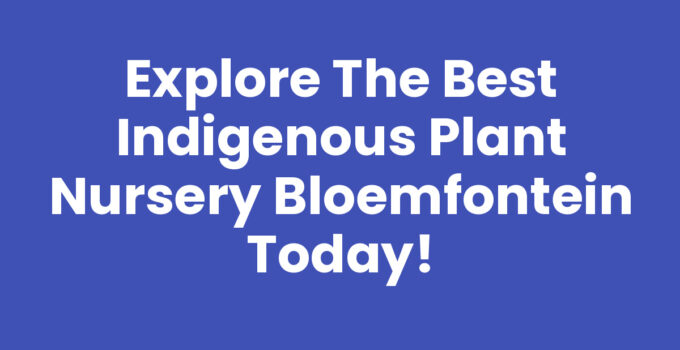As awareness of environmental issues grows, so does the importance of indigenous plants in landscaping and gardening. Located in the heart of South Africa, Bloemfontein boasts a diverse range of flora that is critical for supporting local wildlife and promoting biodiversity. This blog will explore how you can enrich your garden with local plant species by visiting an indigenous plant nursery in Bloemfontein.
Indigenous Plant Nursery Bloemfontein: Your Guide to Choosing Native Plants
Indigenous plant nurseries specialize in native plants that are well-suited to the local climate, soil, and wildlife. At an indigenous plant nursery in Bloemfontein, you can find a vast selection of plants that not only thrive in your garden but also support local ecosystems.
Step 1: Understanding the Importance of Indigenous Plants
Indigenous plants offer numerous benefits, including:
- Adaptation: Native plants are adapted to the local environment, making them less susceptible to pests and diseases.
- Water Efficiency: These plants typically require less water once established, which is crucial in regions prone to drought.
- Biodiversity Support: Indigenous flora provides food and habitat for native wildlife, including birds, insects, and small mammals.
Step 2: Visiting the Nursery
When you visit an indigenous plant nursery in Bloemfontein, consider bringing a list of questions to ask the staff. They can provide insights on:
- Which plants are best suited for your specific garden conditions (sun, shade, soil type, etc.)?
- How to care for the plants you choose, including watering, pruning, and pest management.
- Any special considerations for planting and maintaining indigenous species.
Step 3: Selecting the Right Plants
Some examples of popular indigenous plants you might find at a nursery in Bloemfontein include:
- Aloe Ferox: This striking succulent is not only drought-tolerant but also provides nectar for local birds.
- Arboriculata (Honeybush): Known for its sweet aroma, this plant attracts pollinators and is also used in herbal teas.
- Wilde Aloe: Another hardy variety that blooms beautifully and helps conserve water.
Step 4: Planning Your Garden Layout
After selecting your plants, consider how to best arrange them. Incorporate principles of design, such as:
- Grouping: Plant similar species in clusters for a natural look and to improve pollination.
- Layering: Use taller plants at the back of borders and shorter ones in front, allowing each plant to thrive.
- Color Schemes: Plan your color palette by selecting plants that bloom at different times throughout the year.
Benefits of Indigenous Plants in Urban Gardens
Integrating indigenous plants into urban gardens not only enhances beauty but also promotes sustainability. Some additional benefits include:
- Low Maintenance: Once established, indigenous plants require less care, allowing urban gardeners to focus on other projects.
- Climate Resilience: As the climate changes, indigenous plants have a better chance of surviving and thriving compared to non-natives.
- Community Backing: Supporting indigenous plant nurseries contributes to local economies and encourages conservation efforts.
Conclusion
Visiting an indigenous plant nursery in Bloemfontein opens a world of possibilities for enriching your landscape with native flora. By understanding the benefits of indigenous plants and how to care for them, you contribute to biodiversity, sustainability, and the beauty of your local environment. Whether you’re a seasoned gardener or just beginning, these native plants are your key to a thriving garden.
Frequently Asked Questions
What types of plants can I find at an indigenous plant nursery in Bloemfontein?
You can find a variety of local plants, including succulents, shrubs, and trees that are adapted to the regional climate.
Why should I choose indigenous plants for my garden?
Indigenous plants require less water, support local wildlife, and are adapted to thrive in your local soil conditions.
How do I care for indigenous plants once planted?
Indigenous plants generally need minimal care but monitor moisture levels, prune as needed, and control pests with natural methods.



